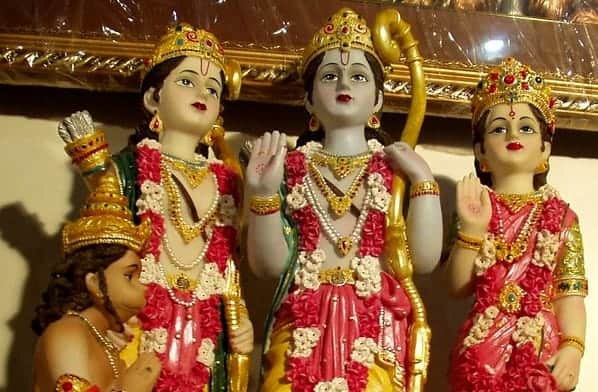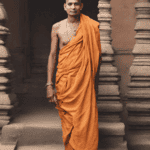Rama in Ramayana is a simple person and lead a simple life without any magical powers. Yet, we treat Rama like a god. Have you ever wondered why? Below is what I have learned from my research.
He is worshiped not because he was an incarnation of Lord Vishnu, rather he is worshiped because he was a man of his principles, words, and deeds despite very hard times. His one footstep was “Dharma” (Righteousness) and another footstep was “Satyam” (Truth).
Let us look into the details for the same.

Brief Story of Rama in Ramayana
Rama is said to be the seventh incarnation of the Hindu god Vishnu. He was the eldest son of Dasaratha, King of Ayodhya. He is the protagonist of the Hindu epic, Ramayana.
Rama’s name is a popular form of greeting among Hindus, and he is the deity most invoked at death. Though born in a royal family, his life was challenged by unexpected changes such as an exile into impoverished and difficult circumstances and ethical questions. He holds an arrow in his right hand and bow in his left hand. He had three brothers, Laxmana, Shatrughna and Bharat. In Mithila, the king Videha hosted Rama and then he met the king’s beautiful daughter Sita. The king declared that the princess will marry only that person, who could manage to bend a huge bow which had once been the weapon of Lord Shiva. Rama, with his strength, now only just bends the bow, but broke it into two halves. And So, he married Sita. The Ramayana states that Lord Rama has ruled his kingdom for about 11,000 years. In Rama Rajya, there was democracy and equality. Everyone was provided with justice by Lord Ram.
Rama’s Birth – Ramanavami
Rama’s birthday is known as Ramanavami, which is one of the most important festivals of the Hindus. The festival is an occasion for moral reflection for many Hindus. The life of Rama is remembered every year in autumn in the form of dramatic plays called Ramleela. Rama was born at the end of the Second Age or Treta-Yuga. He was born in Ayodhya to Kaushalya and Dasaratha, the king of Ayodhya. As the seventh incarnation of Lord Vishnu, Rama is said to have taken birth on earth to annihilate the evil forces of the age. Dasharatha was a strong king and he raised his sons as strong as him. His sons made it their duty to uphold his name and dharma. So, even when Dashratha asked Rama to go to exile, he kept his father’s promise and also upheld his dharma as a son. Dasaratha gave a word to Kaikeyi and he had to honor it. And, in order to make him honor his word, Rama decided to move to the Forests. He was known as the epitome of dharma.
He possessed five qualities throughout his life. Those qualities were,
- TYAGA – Sacrifice
- DAYA – Compassion
- VIDYA – Wisdom
- PARAKARAM – Valor
- DHARAM – Righteousness
He understood the sorrow of not only poor and ill humans and sages but also of all animals, and birds, as in a Ram Rajya, humans and other creatures both live a satisfied and peaceful life.
The below are few things Rama is known for.
Maryada Purushottam Rama
Rama is known as Maryada Purushottam (Epitome of modesty) because he was not only kind and affectionate but considerate the feelings of all around him. He was generous and fearless. He respected his tradition, his citizens and also their opinions. He asked Sita to give Agni Pariksha because of the demands of his Praja (subject) and it was his duty to accept the demands of his Praja. As a king, he was willing to make any amount of personal sacrifice for them.
Rama – A symbol of sacrifice
On Kaikayei’s demand, Dasharatha asked Rama to leave for the exile, without thinking about the comfort and luxury he could get living at the palace, he followed his father’s words. Rama graciously accepted his demand and asked his father, with his characteristic calmness, not to worry so much about so little a problem. Rama sacrificed his kingdom and his parents. During Sita’s exile, many priests suggested him to remarry, he respectfully but firmly refused. As a king, he had to make many sacrifices for his state’s welfare and the priests told him that the sacrifices are needed to be made by Rama along with his wife. He honored the traditional requirement and made a golden picture of Sita. He placed that picture beside him during the sacrifices.
Why did Rama exiled Sita even after he conducted the Agni Pariksha
Even after Rama conducted the Agni Pariksha, his kingdom was unhappy. When he asked his messengers of court about the reason, they told him that the kingdom was not unhappy with him but the queen. They told him that the kingdom’s people question her purity, and they doubted his judgment as their king. Then Rama decided to exile Sita.
How Rama met his sons?
On the bank of Gomati River, Rama was performing an Ashwamedh Yagya. For the completion of the Yagya, Rama had to send a fine horse all over the land. Whoever tied the horse, had to fight with the army accompanying it. If he won, he could have the owner’s kingdom. The horse came to Valmiki’s Ashram. Luv saw the horse and he thought that it would disturb the freedom of his guruji’s ashram. So he tied the horse to a tree. After that, he also defeated the army. Rama met his sons, Luv and Kush at Sage Valmiki’s ashram. He got to know that Hanuma and Bharath got defeated by two children. So, to meet them he decided to go to Sage Valmiki’s ashram. Sage Valmiki told Luv and Kush that Rama was their father.
How Rama killed Ravana?
As per Ramcharitramanas, Rama used 31 arrows to kill Ravana. To kill Ravana, Rama used Brahmastra given to him by Sage Agastya. Brahmastra pierced Ravana’s chest and he died.
Lord Rama’s Death
According to Thiri Rama (Myanmar version of Rama’s life story), the death of Sita leads Rama to drown himself. Rama closed his incarceration in the sacred river Sarayu, a sub river for Manasa Sarovaram, created by Brahma, in his meditation. Nowadays it is called as Guptha Ghat.
Conclusion
Rama proves that he is an ideal husband, brother, king, son and father. He is also one of the greatest warriors, as he was successful in defeating one of the strongest and most resourceful devils of all time, who had gained all his powers by his years of devotion and Tapasya to Lord Brahma.
